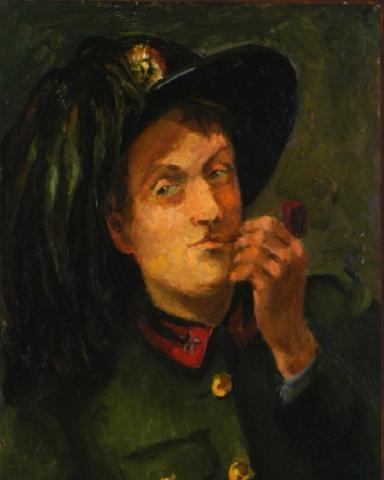The Artwork of the Month of the Museo della Scuola Romana - April 2022
Alberto Ziveri
(Roma, 1908 - Roma, 1990)
Autoritratto come bersagliere, 1937
Oil on panel
MSRo40

The painting represents the same artist, smoking a pipe, dressed in his old green military bersagliere uniform with golden buttons and a red collar with golden stars. The figure is facing to his left, looking winking to his right. The bust is slightly turned to the left, one hand raised to hold a pipe in the mouth; on his head he wears a bersagliere hat with thick plumage falling down. It is part of a rich gallery of self-portraits made by Ziveri during his career, including many in costume, such as the "Bersagliere", undoubtedly one of the artist's most famous. It was to be his favourite "disguise", and was repeated several times, becoming a pictorial obsession during the war years. The work is highly illustrative of the new manner inaugurated by the artist in 1937, a crucial moment in his artistic research.
In that year, Ziveri visited the International Exhibition in Paris, where he saw Picasso's Guernica still freshly painted, an exhibition dedicated to El Greco, and the markets of Les Halles. He then visited Holland and encountered the works of Rembrandt. This led to a total change in his style, which can already be seen in this self-portrait, in which the colours are completely different from his earlier works, which stood as examples of tonal painting instead: Ziveri became a realist, later choosing more everyday scenes as his subjects with the intention of communicating the emotions the artist feels when seeing the same scene, but without judgement.
Alberto Ziveri was born in Rome in 1908 and trained at the School of Ornamental Arts and the Liceo Artistico. He became friends with the painter Guglielmo Janni, who introduced him to tonal painting, and the sculptor Pericle Fazzini, with whom he had his first solo exhibition in 1933 at the Dario Sabatello Gallery, a combination that was repeated in 1984 at the National Gallery of Modern Art in Rome. He also met the artists Mario Mafai and Katy Castellucci, with whom he had a sentimental relationship. His success was mainly due to the change in style at the end of the 1930s. In the post-war period he continued to exhibit, participating in the Venice Biennale (1948 to 1956) and the Quadriennale in Rome (1959, 1973).
The meeting with the gallery owner Netta Vespignani and the association that was born from it led them to commit themselves to the diffusion and renewal of public interest in the Roman School and, in 1983, to found the Archivio della Scuola Romana Association together with Miriam Mafai, Maurizio Fagiolo dell'Arco and Antonello Trombadori. In 2006, the collection and archive of this association were donated to the City of Rome for the establishment of the Museum and Archive of the Roman School, which is located in Villa Torlonia.
It was within the papers of this Archive that an article emerged regarding the artist's participation in the 1939 Quadriennale in Rome, which reported that "it is curious to note that one of the most scrupulous purists of tone at the previous Quadriennale: Ziveri, in a portrait exhibited today, strives to model like the most avid chiaroscuro artist" ("Pittura e scultura alla Quadriennale" by Leopoldo Bacherini, which appeared in "Tutto" on 11 March 1939). The new 'dark manner' of painting, recently inaugurated, appeared to the contemporary public and critics as a radical and convincingly pursued change.
Back to the section > The Artwork of the Month of the Museo della Scuola Romana











































